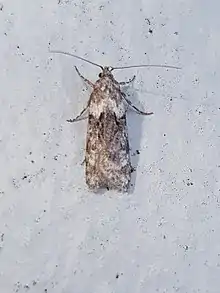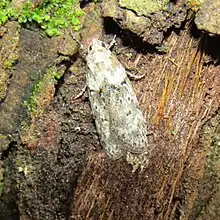| Izatha convulsella | |
|---|---|
 | |
| Scientific classification | |
| Domain: | Eukaryota |
| Kingdom: | Animalia |
| Phylum: | Arthropoda |
| Class: | Insecta |
| Order: | Lepidoptera |
| Family: | Oecophoridae |
| Genus: | Izatha |
| Species: | I. convulsella |
| Binomial name | |
| Izatha convulsella (Walker, 1864) | |
| Synonyms | |
| |
Izatha convulsella is a moth of the family Oecophoridae. It is endemic to New Zealand. It is similar in appearance to its close relative Izatha gekkonella but is slightly larger and more white/grey in appearance and is more wide spread in geographic range than its close relative.
Taxonomy
.jpg.webp)
This species was first described by Francis Walker in 1864 under the name Gelechia convulsella.[1][2] Walker based his description on specimens collected in Nelson by Mr Oxley.[3] These specimens are held at the Natural History Museum, London.[4]
Description
The wingspan is 14–20 mm for males and 13.5–19 mm for females.[3] Adults are on wing from late September to February.[3] This species is very similar in appearance to its close relation I. gekkonella.[3] The most accurate way to confirm the identity of specimens is by dissection of the male genitalia as I. convulsella has a comb like structure in the reproductive organ of the males of the species.[3] Generally I. convulsella is slightly larger than I. gekkonella and has fewer yellow-tipped grey scales and so has a more white and grey appearance in comparison to the I. gokkonella which, as a result of having a larger quantity of these scales, has a more brownish appearance.[3] I. convulsella also has lighter coloured hindwings in comparison to I. gekkonella.[3]
Geographic range
This species is endemic to New Zealand.[5] It is widespread in the eastern part of the South Island.[3] In the North Island, it has only been recorded from Wellington, Ōtaki, Palmerston North, Taihape and Waipawa.[3] This species is not found in Auckland.[3]
Host species

Larvae have been recorded living under the bark of Dacrydium cupressinum.[3] The true food plant may be lichens growing on the bark.[3]
References
- ↑ Dugdale, John Stewart (23 September 1988). "Lepidoptera - annotated catalogue, and keys to family-group taxa". Fauna of New Zealand. 14: 1–264.
- ↑ Walker, Francis (1864). "Part XXIX. Tineites". List of the Specimens of Lepidopterous Insects in the Collection of the British Museum. 29: 563–835. Retrieved 12 February 2018 – via Biodiversity Heritage Library.
- 1 2 3 4 5 6 7 8 9 10 11 12 Hoare, Robert J. B. (2 September 2010). "Izatha (Insecta: Lepidoptera: Gelechioidea: Oecophoridae)". Fauna of New Zealand. 65: 1–201.
- ↑ "Record 1500917 Izatha convulsella Walker". data.nhm.ac.uk. 15 May 2009. Retrieved 6 March 2021.
- ↑ "Izatha convulsella (Walker, 1864)". NZOR. 2020. Retrieved 6 March 2021.